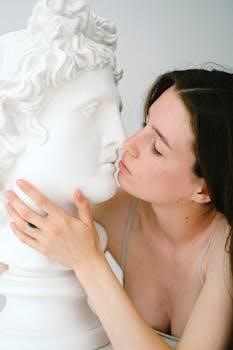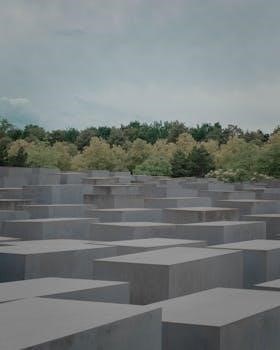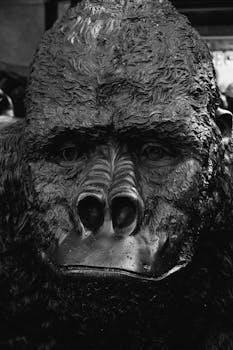The exploration of modern art’s evolution is significantly aided by resources such as the History of Modern Art‚ particularly its 7th edition․ This edition‚ authored by H․H․ Arnason and Elizabeth C․ Mansfield‚ delves deep into artistic movements‚ offering a comprehensive study․
Overview of Modern Art’s Scope
Modern art‚ as examined within the 7th edition of History of Modern Art‚ encompasses a vast array of artistic expressions‚ spanning from the mid-nineteenth century to the contemporary era․ This period is marked by radical shifts in artistic styles‚ techniques‚ and philosophies․ The scope includes diverse mediums‚ such as painting‚ sculpture‚ architecture‚ and photography‚ showcasing the evolution of artistic practices․ Moreover‚ this era witnesses the emergence of various movements like Impressionism‚ Cubism‚ Surrealism‚ and Abstract Expressionism‚ each contributing uniquely to the artistic landscape․ The 7th edition also explores the social‚ cultural‚ and political contexts that influenced these developments‚ providing a deeper understanding of the forces shaping modern art․ This extensive overview ensures a comprehensive grasp of the complexities and innovations within modern artistic history․

Key Authors and Editions
The History of Modern Art is primarily credited to H․H․ Arnason‚ with significant contributions from Elizabeth C․ Mansfield․ The 7th edition marks a notable update‚ reflecting changes in art historical research․
H․H․ Arnason’s Contribution
H․H․ Arnason’s foundational work in art history is central to the History of Modern Art series․ His expertise and original scholarship laid the groundwork for understanding the complexities of modern artistic movements․ Arnason’s approach emphasized the unique formal aspects of art‚ providing a structure for analyzing paintings‚ sculptures‚ and other mediums․ His contributions extend beyond mere chronological accounts; he delved into the intellectual and cultural contexts shaping artistic expression․ Arnason’s insight remains a cornerstone of art historical studies․ His work‚ even in subsequent editions‚ continues to influence how scholars and students understand the development of modern art from the mid-nineteenth century to the present day․ His legacy ensures the series’ position as a key reference for those exploring the nuances of modern art history‚ and the 7th edition reflects the enduring impact of his initial vision․
Elizabeth C․ Mansfield’s Role
Elizabeth C․ Mansfield has significantly shaped the History of Modern Art‚ particularly in the 7th edition․ Her scholarship builds upon H․H․ Arnason’s groundwork‚ bringing a fresh perspective to the analysis of modern art․ Mansfield’s contributions are evident in the text’s updated research and inclusion of contemporary art developments․ She has carefully revised the material to embrace the latest archaeological and art historical findings․ Her expertise ensures that the book remains relevant and current in the ever-evolving field of modern art history․ Mansfield’s role is not just as a reviser; she adds her own voice‚ enriching the narrative with her deep understanding of artistic and cultural contexts․ She has expanded the book’s coverage‚ making it a vital resource for contemporary studies of the field․ Her dedication is apparent in the thoroughness and clarity with which she presents the complex history of modern art․
Significance of the 7th Edition
The 7th edition of History of Modern Art holds a significant place in art historical studies due to its comprehensive updates and revisions․ This edition‚ co-authored by H․H․ Arnason and Elizabeth C․ Mansfield‚ represents a substantial upgrade from previous versions․ It incorporates new research findings‚ particularly in the areas of archaeology and art historical analysis․ The 7th edition extends its coverage to include more contemporary art movements and artists‚ making it relevant to the present day․ It maintains the book’s traditional emphasis on formal analysis while integrating socio-cultural contexts‚ providing a balanced perspective․ This edition reflects the most recent scholarship‚ ensuring readers have access to the latest understanding of modern art’s evolution․ The significance of the 7th edition lies in its ability to synthesize historical depth with contemporary relevance‚ making it an invaluable resource for students and scholars alike․ It serves as a critical guide for navigating the complex landscape of modern art history․

Content Coverage in the 7th Edition
The 7th edition extensively covers painting‚ sculpture‚ architecture‚ and photography‚ offering a detailed exploration of each medium․ It also includes contemporary art and recent developments in art history research․
Focus on Painting‚ Sculpture‚ Architecture‚ and Photography
The 7th edition of History of Modern Art provides a detailed analysis of painting‚ sculpture‚ architecture‚ and photography‚ which are foundational elements within the scope of modern artistic expression․ This comprehensive approach ensures that students gain a thorough understanding of each medium’s unique evolution and its contribution to the broader narrative of modern art․ The text meticulously examines the stylistic developments‚ technical innovations‚ and key figures that have shaped the trajectory of each discipline․ It explores various movements and tendencies within painting‚ from Impressionism to Abstract Expressionism‚ and analyses the diverse forms and materials used in sculpture‚ from classical to contemporary practices․ Furthermore‚ the architectural section analyses the diverse styles and innovations‚ from the Bauhaus to postmodernism‚ while the photography section follows its evolution from its early days to its status as a fine art medium․ This section is crucial to understanding the modern art scene․
Inclusion of Contemporary Art
The 7th edition of History of Modern Art distinguishes itself through its significant inclusion of contemporary art‚ acknowledging the dynamic and ever-evolving nature of artistic production․ This section of the book explores recent developments in art‚ covering diverse media and innovative practices that challenge traditional notions of art․ It examines art forms such as installations‚ performance art‚ and digital art‚ while considering the social‚ political‚ and cultural contexts that shape these contemporary artistic expressions․ By incorporating contemporary art‚ the 7th edition provides a comprehensive overview that extends beyond the historical canon‚ reflecting the current state of artistic practice‚ which includes the work of artists like Damian Hurst and Matthew Barney․ This commitment ensures that readers gain a well-rounded understanding of modern art from its origins to its most recent forms‚ promoting engagement with the latest artistic trends․
Developments in Art Historical Research
The 7th edition of History of Modern Art reflects significant advancements in art historical research‚ showcasing a commitment to incorporating new scholarly perspectives and methodologies․ This edition has been carefully revised to integrate the latest findings in archaeology and art historical studies‚ ensuring the text remains current and relevant․ These developments include a deeper analysis of the social‚ political‚ and cultural contexts that influence artistic creation and interpretation․ The authors also incorporate evolving discussions on previously marginalized art forms and artists‚ promoting a more inclusive and comprehensive understanding of art history․ This updated approach provides a more nuanced account of modern art’s trajectory‚ moving beyond traditional narratives․ By acknowledging new research‚ the 7th edition ensures its continued status as a valuable resource for art scholars and enthusiasts alike‚ offering fresh insights into the field of art history․

Availability and Access
The 7th edition of History of Modern Art is accessible in digital and eTextbook formats․ Additionally‚ the possibility of a free PDF version enhances availability for wider study and research․
Digital and eTextbook Formats
The 7th edition of History of Modern Art by H․H․ Arnason and Elizabeth C․ Mansfield is widely available in contemporary digital formats‚ catering to the preferences of modern learners and researchers․ The eTextbook version offers a convenient alternative to the traditional print format‚ allowing users to access the comprehensive text on various devices‚ such as tablets‚ laptops‚ and smartphones․ This digital accessibility is particularly beneficial for students engaging in online courses or those requiring remote access to study materials․ Furthermore‚ these formats often incorporate features such as keyword searching‚ highlighting‚ and note-taking capabilities‚ enhancing the overall learning experience․ The digital options also facilitate ease of navigation and quick reference to specific sections‚ making it a valuable resource for both casual readers and academic scholars․ The shift towards digital resources also aligns with contemporary educational trends‚ emphasizing flexibility and accessibility in learning․ This availability ensures that a wider audience can engage with this definitive text on modern art history‚ regardless of their location or preferred learning method․ It also promotes sustainability by reducing the need for physical copies․
Free PDF Availability
The accessibility of the 7th edition of History of Modern Art is a significant factor for students and enthusiasts of the subject․ While the official digital and eTextbook formats are available through purchase‚ the possibility of accessing a free PDF version is often a subject of interest․ Finding a legitimate‚ free PDF of the complete 7th edition can be difficult due to copyright restrictions․ However‚ some institutions or online platforms may offer limited access to specific chapters or excerpts․ It is crucial for users to be aware of the legal implications of downloading and using unofficial PDF versions‚ as these may infringe upon copyright laws․ Additionally‚ such versions might not always be of the same quality as the official publications and could contain errors or omissions․ The pursuit of free resources must be balanced with respect for intellectual property rights and the need to support authors and publishers․ Students should consider exploring libraries and other legitimate avenues for accessing the book if a free PDF is not legally accessible․ The official digital formats‚ despite requiring payment‚ offer the most reliable and up-to-date version of this important text․

Related Art Historical Context
Understanding modern art requires considering its roots‚ including influences from Late Antique and Early Christian art․ Furthermore‚ the Soviet Outsider Art of the 1970s-1980s offers a contrasting perspective․
Influence of Late Antique and Early Christian Art
The trajectory of modern art is not solely a product of recent centuries; it is also subtly shaped by the legacy of Late Antique and Early Christian art․ These earlier periods provided foundational concepts and stylistic approaches that continue to resonate within modern artistic expression․ The symbolic language‚ use of light and shadow‚ and the development of narrative within religious contexts during these times have left an indelible mark․ For example‚ the exploration of abstraction and the flattening of perspective‚ seen in Byzantine mosaics and early Christian frescoes‚ can be viewed as precursors to certain trends in modern painting and sculpture․ Moreover‚ the spiritual intensity and emotional depth sought by artists during these eras laid groundwork for the subjective and introspective qualities often found in modern art․ Understanding these historical connections enriches our comprehension of the complex tapestry of art history and reveals the deep roots of what we consider ‘modern’․ The use of certain materials and techniques‚ even the way artists approached their subjects‚ were influenced by these periods and continue to inspire innovation․
Soviet Outsider Art of the 1970s-1980s
The exploration of Soviet Outsider Art from the 1970s and 1980s offers a unique lens through which to understand artistic expression outside of mainstream‚ officially sanctioned channels․ This period saw the emergence of artists who‚ often working in isolation‚ created works that challenged the prevailing norms of socialist realism․ These artists‚ frequently self-taught and without formal training‚ developed distinctive styles characterized by raw emotion and an often-surreal aesthetic․ The art produced during this time reflects the socio-political realities of the Soviet era‚ offering a glimpse into the personal struggles and internal landscapes of the artists themselves․ It’s important to recognize that this art movement operated outside the established art world‚ with limited opportunities for exhibition or recognition․ The exploration of this movement within art historical discourse provides a critical perspective on the diverse range of artistic practices during the late Soviet period and expands our understanding of what constitutes modern art․ This artistic movement is significant as a demonstration of individual expression during politically restrictive times․